News
20242023202220212020
Flavored Oral Nicotine Pouches as Chewing Gums – Interview by Irfan Rahman, PhD
Monday, November 27, 2023
ZYN Pouches Are Gaining Popularity—How Do They Compare to Smoking and Vaping?
ZYN pouches are growing in popularity, and it could be a problem.
There are multiple brands of nicotine pouches, but ZYN has recently exploded on platforms like TikTok, with videos on the topic garnering 292.6 million views.
Nicotine pouches are purportedly intended to help people stop smoking cigarettes, Irfan Rahman, PhD, who runs a lab that conducts research on toxicants at the University of Rochester Medicine, told Health.
But the products have not been sufficiently studied, and it’s impossible to say whether or not they actually help with smoking cessation.
“There’s no data available,” Rahman said. “If somebody’s saying that, they’re making up data.”
Read More: Flavored Oral Nicotine Pouches as Chewing Gums – Interview by Irfan Rahman, PhDDeborah Cory-Slechta: Research Pointing to Herbicide and Parkinson’s Association is 'Overwhelming'
Wednesday, November 22, 2023
The professor of Environmental Health Sciences appeared on ABC News’ Nightline to discuss the growing scientific evidence linking the widely used herbicide paraquat to Parkinson’s disease and efforts to undermine concerns about the chemical’s health risks (Part 1, Part 2). Read about how URMC researchers are leading efforts to understand how environmental exposure to chemicals is driving a rise in rates of Parkinson’s, making it the world’s fastest growing neurological disease.
Toxicology Training Program Well-Represented in 2023 GEPA Awards!
Monday, November 13, 2023
Catherine Caballero – URSMD Meliora Scholarship
Emily Quarato – Graduate Student Award for Excellence in Equity and Inclusion
Ania Majewska – Graduate Student Society Mentoring Award
Jacques Robert – Outstanding T32 Program Director Award
Kirsi Jarvinen-Seppo – Excellence in Postdoctoral Mentoring Award
Marissa Sobolewski – Outstanding Graduate Student Teacher Award
Toxicology Celebrates 50 Years of Training
Thursday, September 21, 2023
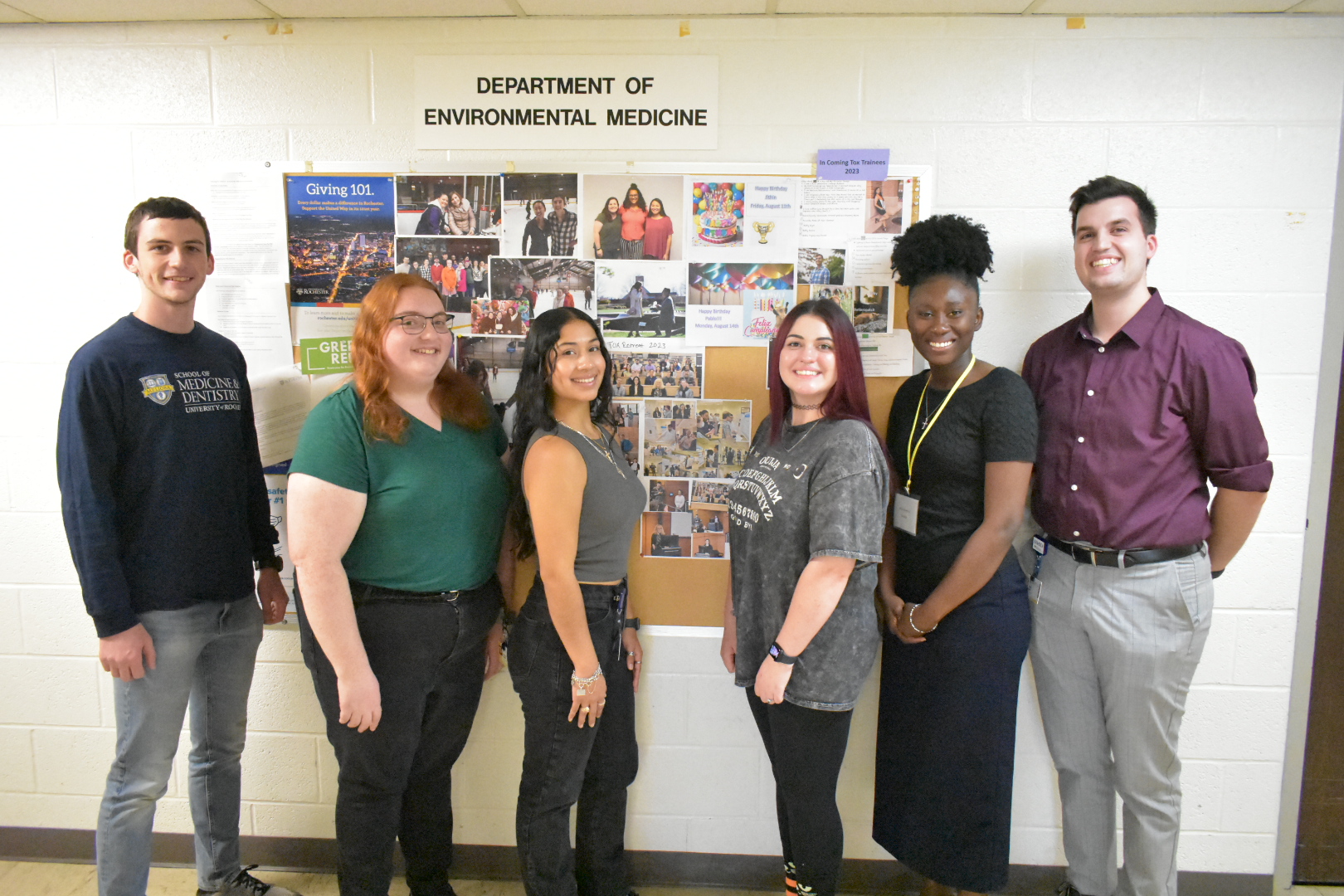
The latest cohort of Toxicology Ph.D. students
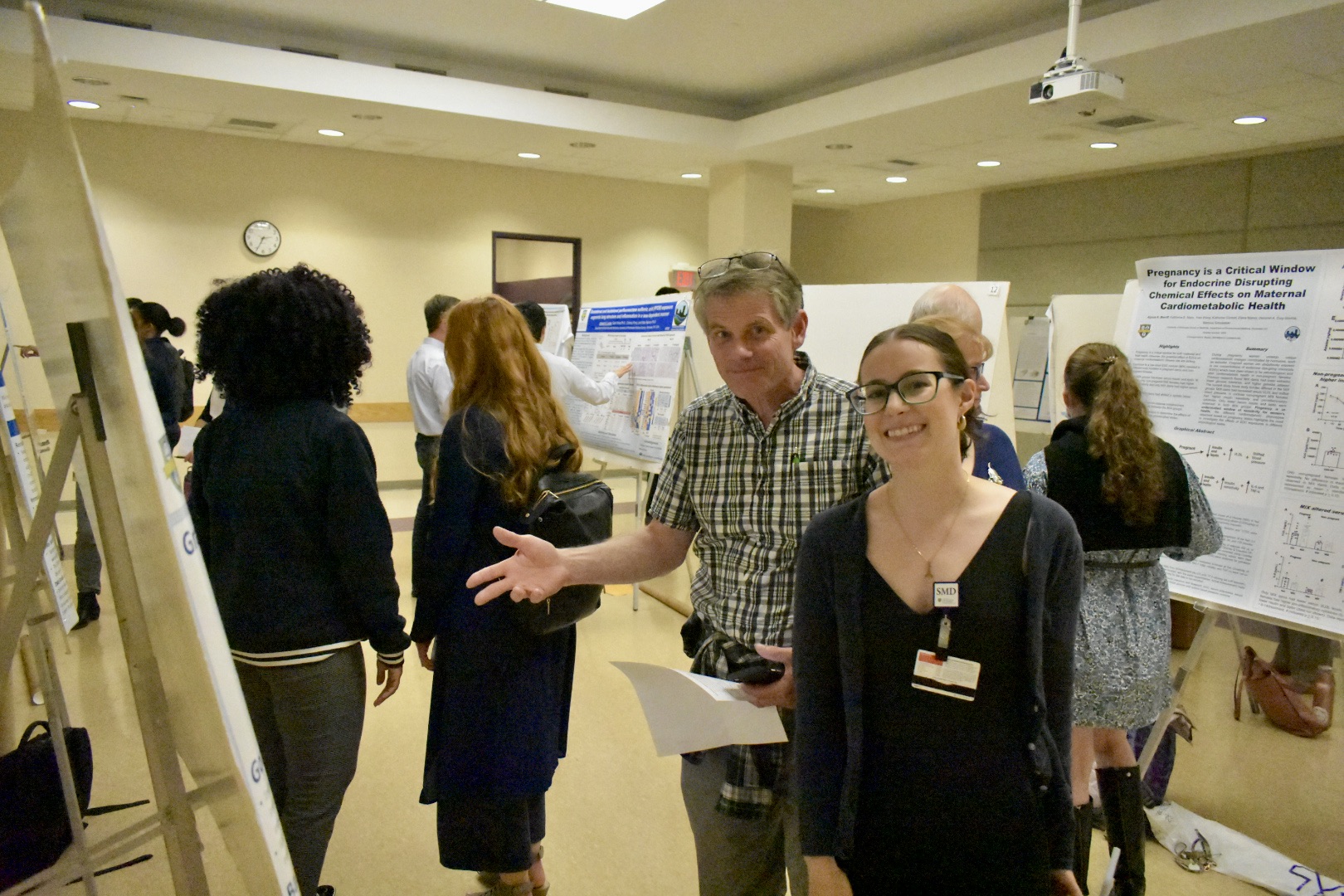
Matt Rand, Ph.D., co-director of the Toxicology program (left), with 3rd-year trainee Ryan Owens.
 Martha Susiarjo, Ph.D., associate professor of Environmental Medicine, hosted Toxicology trainees at her home in October 2022 to celebrate the start of fall with a pumpkin carving party.
Martha Susiarjo, Ph.D., associate professor of Environmental Medicine, hosted Toxicology trainees at her home in October 2022 to celebrate the start of fall with a pumpkin carving party.
In August, our Toxicology Ph.D. program’s T32 training grant was renewed for another five years, bringing them to 50 consecutive years teaching the next generation of trainees. Alums of the program have gone on to make important contributions in toxicology, environmental health, and public policy, dating all the way back to the Manhattan Project. Co-program director Alison Elder, Ph.D., says, “If this program was picked up and moved to another university, I’m not so sure it would have the same success.”
Toxicology Ph.D. program leaders credit the emphasis on interdisciplinary training and a strong sense of community for the program’s success. Students are exposed to a wide range of disciplines, including biochemistry, pharmacology, neuroscience, and epidemiology, which prepares them to address the complex challenges of the field. This, and the close-knit trainee cohorts, have been the program's backbone for five decades now.
“There's a willingness of our faculty and trainees to cross silos to get good science done, which benefits everyone," says Elder, associate professor of Environmental Medicine. “Toxicology is an applied science because trainees borrow from different fields to understand the impact of various stressors on living systems. The interdisciplinary training we give them is crucial.”
Faculty who support the program aren’t ‘jack of all trades’ scientists, as Elder likes to say. They lean on the expertise of colleagues, as well as their own, to bring everyone up to a higher level of rigor and discovery, including the trainees.
This also contributes to another key piece to the program's success, which is the camaraderie that’s felt from the moment you set foot on campus.
"We're fortunate to have small but tight cohorts of students," says Matt Rand, Ph.D., co-director of the program and an associate professor of Environmental Medicine since 2012. "I could feel it right away when I got here."
Even before prospective trainees accept, they’re invited to dinners at faculty homes during the interview process, creating a congenial and relaxed atmosphere for incoming students to get a sense of the type of people who conduct research and mentor trainees at SMD.
And when trainees eventually leave campus, they stay connected. For instance, the program recently developed a new course in risk assessment with input from alumni, several of whom serve as lecturers in the course.
"We send them out into the world, then they come back and help us," says Elder.
The field of toxicology has evolved significantly over the years, from evaluating very fundamental endpoints of toxic exposures, like birth defects or mortality, to more sensitive and widely applicable endpoints of, for example, behavioral deficits associated with neurological and/or developmental toxic insults.
Widening the lens even more is the move away from mortality and organ-specific toxicological endpoints towards a more holistic and mechanisms-driven approach that better enables translation to humans, always keeping in mind the central tenet of the field—it is the dose that makes something relatively more or less dangerous than something else.
Alumni regularly return to campus to give career and other lectures, serve as outside mentors for trainees, and are a great bridge for the program in staying on top of research trends, ultimately creating a better experience for the trainees.
Other longstanding training programs within the School of Medicine and Dentistry include:
A Game Plan for Timing Your Flu, Covid and RSV Shots This Fall with Commentary by David Topham
Tuesday, September 19, 2023
Trying to figure out when a virus will peak is a guessing game, says David Topham, the Marie Curran Wilson and Joseph Chamberlain Wilson Professor in the Department of Microbiology and Immunology. While respiratory viruses often pick up in the fall and peak in the winter, in recent years the COVID-19 pandemic disrupted the usual patterns. RSV and influenza activity started earlier than usual last year. “COVID-19 has really thrown everything into turmoil,” says Topham.
Read More: A Game Plan for Timing Your Flu, Covid and RSV Shots This Fall with Commentary by David TophamStudy: Marijuana Users Found to Have Higher Levels of Toxic Metals In Blood and Urine
Friday, September 15, 2023
Marijuana smokers may unknowingly be consuming heavy metals, a new study shows.
Heavy metals accumulate in the body and have been linked to a host of health issues including cancer, cognitive impairment, and heart disease.
And, people consuming marijuana may be more at risk of these toxins entering their bloodstream.
Irfan Rahman, PhD, director of Flavor Inhalation Toxicology Research at the University of Rochester Medical Center told Health that while the gut contains enzymes that can help the body get rid of heavy metals (particularly lead), the lungs don’t have the same system in place.
This means inhaling marijuana, by smoking or vaping, may be more damaging than taking an edible.
On top of this, the logistics of vaping could add another aspect of heavy metal exposure for marijuana users.
The reduction process that extracts cannabidiol from the cannabis plant can introduce heavy metals and other contaminants, including solvents used to extract essential oils from the flower, Rahman explained.
If done incorrectly, these lab-made marijuana extracts have a higher chance of releasing metals when they hit the hot coils of a vape pen, he said.
Read More: Study: Marijuana Users Found to Have Higher Levels of Toxic Metals In Blood and UrineWhat Makes Us Tick: Smoking’s Effect on Our Biological Clock
Thursday, August 10, 2023
Cells in nearly every human tissue and organ contain proteins that govern circadian rhythms. In essence, these molecules together act as a microscopic clock timed to waxing and waning sunlight.
“When sunlight enters your eyes in the morning, it sends a signal to the pineal gland in your brain that sets off a chain reaction of hormone production, waking your body up and affecting your appetite, body temperature, blood pressure, and more,” Rahman explained. “As darkness sets in, your body winds down, preparing for sleep.”
Rahman studies how environmental exposures affect molecular clock proteins in the lungs.
“The molecular clock’s purpose is to prepare your body for expected changes in the environment, like the times for activity, times for sleep, and times to eat,” Rahman said. “However, environmental exposures, including tobacco smoke and vaping, can disrupt the production of clock molecules, leading not only to changes in sleep cycles but also to lung injury or respiratory disease.”
For example, in a study on the effects of trendy e-cigarette and tobacco products on lung health, Rahman and team found that exposure to either waterpipe smoke or e-cigarette vapor altered expression of molecular clock proteins in mouse lungs. Those changes could in turn affect lung function, the authors suggested.
Jet lag, night-shift work, and blue light from electronic devices can also affect the molecular clock. Smoking or vaping can potentially exacerbate the impacts of those factors.
Read More: What Makes Us Tick: Smoking’s Effect on Our Biological ClockDebra Cory-Slechta Explains How Wildfire Smoke and Air Pollution can Harm the Brain
Thursday, August 3, 2023
In an interview with Rick Woychik, director of the National Institute of Environmental Health Sciences, the professor of Environmental Medicine shares how research into how fine air particles impact the brain is transforming our understanding of neurodegenerative and neurodevelopmental disorders. Woychik interviewed Cory-Slechta after seeing her presentation at the first Human Health and the Environment Research Symposium at the Medical Center in June, where he was a guest speaker.
Read More: Debra Cory-Slechta Explains How Wildfire Smoke and Air Pollution can Harm the BrainElizabeth Plunk Receives NIH F31
Tuesday, July 18, 2023
Congratulations to Toxicology trainee, Elizabeth Plunk, on receiving an F31 award from the National Institute of Environmental Health Sciences! The title of Elizabeth’s project is ‘The Effects of Gestational and Lactational Exposure to Perfluorohexanoic Acid on Cerebellum Development in the Mouse’, which is co-sponsored by her doctoral mentor, Dr. Ania Majewska, and Dr. Marissa Sobolewski.
2023 Tox Retreat Award Winners
Friday, May 26, 2023
The Toxicology Training Program celebrated its annual Retreat and Awards Ceremony on Thursday, May 25! If you have not already done so, please congratulate the awardees the next time you see them.
Neuman Award for Exemplary Scholarship and Citizenship
Alex Strohm
 Alex graduated from Michigan State University in 2018 with a Bachelor of Science degree in Biochemistry and Molecular Biology. She is mentored by Dr. Ania Majewska in her studies that are focused on the effects of ionizing radiation on innate immune cells in the brain, namely microglia. She combines two-photon in vivo imaging, immunohistochemistry, and complex image analysis to pursue her aims, as you saw earlier today. She has used these to discover that microglial dynamics and interactions with neurons are remarkably resilient to radiation damage, but that microglial function has profound effects on radiation-induced changes in the brain. Alex has many scientific interests, embodied in side projects that explore 1) the effects of developmental PFAS exposure on microglial responses to radiation and 2) the effects of exercise on microglia in the normal brain and in the context of Alzheimer’s disease. She has published co-authored papers and has several first-author papers being prepared for submission soon.
Alex graduated from Michigan State University in 2018 with a Bachelor of Science degree in Biochemistry and Molecular Biology. She is mentored by Dr. Ania Majewska in her studies that are focused on the effects of ionizing radiation on innate immune cells in the brain, namely microglia. She combines two-photon in vivo imaging, immunohistochemistry, and complex image analysis to pursue her aims, as you saw earlier today. She has used these to discover that microglial dynamics and interactions with neurons are remarkably resilient to radiation damage, but that microglial function has profound effects on radiation-induced changes in the brain. Alex has many scientific interests, embodied in side projects that explore 1) the effects of developmental PFAS exposure on microglial responses to radiation and 2) the effects of exercise on microglia in the normal brain and in the context of Alzheimer’s disease. She has published co-authored papers and has several first-author papers being prepared for submission soon.
Alex also exhibits strong leadership skills and has served as a lab mentor to three undergraduate students, rotating graduate students, and other lab members. One of those undergrads, Sadie Oldfield, was awarded a 2023 Discover Grant for a summer research project in the lab to work on the PFAS study. She also served as a UR2 mentor and has been an alumni ambassador. Last summer and fall, Alex volunteered with the Center for Public Health and Environmental Assessment to work on a project about integrating toxicology into the risk assessment process.
Weiss Toxicology Scholar Award
Alyssa Merrill
 Alyssa’s project focuses on the effects of endocrine disrupting chemical exposures during pregnancy on later life maternal health. For example, she just published a paper that showed that perfluorooctonoic acid – delivered in the diet during pregnancy – caused a decrease in the dams’ maternal behavior and increased anxiety-like behavior after weaning. Alyssa is also involved in Program and other leadership and service activities, the organization of the 2023 retreat being one example. She is mentored by Drs. Debbie Cory-Slechta and Marissa Sobolewski.
Alyssa’s project focuses on the effects of endocrine disrupting chemical exposures during pregnancy on later life maternal health. For example, she just published a paper that showed that perfluorooctonoic acid – delivered in the diet during pregnancy – caused a decrease in the dams’ maternal behavior and increased anxiety-like behavior after weaning. Alyssa is also involved in Program and other leadership and service activities, the organization of the 2023 retreat being one example. She is mentored by Drs. Debbie Cory-Slechta and Marissa Sobolewski.
Elizabeth Plunk
 Elizabeth’s project is focused on the effects of gestational and lactational exposure to perfluorohexanoic acid (PFHxA) on cerebellar development. She is making great strides in her graduate work, demonstrates strong science communication skills in translating her work for a broad audience, and is highly engaged in the life of our Training Program. She is mentored by Dr. Ania Majewska.
Elizabeth’s project is focused on the effects of gestational and lactational exposure to perfluorohexanoic acid (PFHxA) on cerebellar development. She is making great strides in her graduate work, demonstrates strong science communication skills in translating her work for a broad audience, and is highly engaged in the life of our Training Program. She is mentored by Dr. Ania Majewska.
Infurna Publication Awards
Joe Lucas
 Lucas JH, Wang Q, Rahman I. Perfluorooctane Sulfonic Acid Disrupts Protective Tight Junction Proteins via Protein Kinase D in Airway Epithelial Cells. Toxicol Sci 190(2):215-226, 2022. In light of emerging epidemiological links between perfluorooctane sulfonic acid (PFOS) levels and chronic lung diseases, Joe’s paper examined the hypothesis that exposure of cultured human airway epithelial cells to PFOS would impact barrier permeability function and intercellular junction protein levels. PFOS indeed caused a decrease in barrier function, perturbed the organization of junctional proteins, and reduced their levels. Joe further demonstrated that these changes were mediated via protein kinase D.
Lucas JH, Wang Q, Rahman I. Perfluorooctane Sulfonic Acid Disrupts Protective Tight Junction Proteins via Protein Kinase D in Airway Epithelial Cells. Toxicol Sci 190(2):215-226, 2022. In light of emerging epidemiological links between perfluorooctane sulfonic acid (PFOS) levels and chronic lung diseases, Joe’s paper examined the hypothesis that exposure of cultured human airway epithelial cells to PFOS would impact barrier permeability function and intercellular junction protein levels. PFOS indeed caused a decrease in barrier function, perturbed the organization of junctional proteins, and reduced their levels. Joe further demonstrated that these changes were mediated via protein kinase D.
Christina Post
 Post CM, JR Myers, B Winans, BP Lawrence. Postnatal administration of S-adenosylmethionine restores developmental AHR activation-induced deficits in CD8+ T cell function during influenza A virus infection. Toxicol Sci 192(2):233-246, 2023. This very elegantly-designed and -executed study in mice that were exposed to human-relevant doses of TCDD presented impactful findings about 1) the broad TCDD-mediated changes in CD8+ T-cell functionality in the context of influenza virus challenge and 2) that increased DNA methylation, but not decreased methylation, reversed the effects of TCDD on the CD8 T-cells. The study has high environmental health relevance, is developmentally-focused, and delivers keen mechanistic insight that could be exploited to counteract the adverse effects of TCDD on the immune system.
Post CM, JR Myers, B Winans, BP Lawrence. Postnatal administration of S-adenosylmethionine restores developmental AHR activation-induced deficits in CD8+ T cell function during influenza A virus infection. Toxicol Sci 192(2):233-246, 2023. This very elegantly-designed and -executed study in mice that were exposed to human-relevant doses of TCDD presented impactful findings about 1) the broad TCDD-mediated changes in CD8+ T-cell functionality in the context of influenza virus challenge and 2) that increased DNA methylation, but not decreased methylation, reversed the effects of TCDD on the CD8 T-cells. The study has high environmental health relevance, is developmentally-focused, and delivers keen mechanistic insight that could be exploited to counteract the adverse effects of TCDD on the immune system.
Most Inquisitive Student Award
 Elizabeth Plunk
Elizabeth Plunk
Best Poster Presentation by a First-Year Student
 Alma Avila Oropeza
Alma Avila Oropeza
Best Poster Presentation
 Thomas Lamb
Thomas Lamb
Best Platform Presentation
 Emily Quarato
Emily Quarato
Mentoring Award
 Addie Weidner
Addie Weidner
University Award Recipients
Friday, May 26, 2023
 Congratulations to Knickole Bergman, a rising second-year Toxicology Program trainee, on being selected for a Mary L. and Robert L. Sproull University fellowship. Knicki just joined the laboratory of Dr. Martha Susiarjo.
Congratulations to Knickole Bergman, a rising second-year Toxicology Program trainee, on being selected for a Mary L. and Robert L. Sproull University fellowship. Knicki just joined the laboratory of Dr. Martha Susiarjo.
 Congratulations to Alexandra Strohm on being selected as a 2023-2024 recipient of the University’s Wright Goodman Dissertation fellowship. Alex is mentored by Dr. Ania Majewska.
Congratulations to Alexandra Strohm on being selected as a 2023-2024 recipient of the University’s Wright Goodman Dissertation fellowship. Alex is mentored by Dr. Ania Majewska.
The 2023 SOT Leading Edge in Basic Science Award Recognizes Irfan Rahman for His Contributions to Pulmonary Toxicology and Specifically How E-Cig and Cigarette Smoke Causes Lung Injury and Disease
Thursday, April 6, 2023

 This award recognizes a scientist who, based on research, has made a recent (within the last five years), seminal scientific contribution/advance to understanding fundamental mechanisms of toxicity. The recipient should be a respected basic scientist whose research findings are likely to have a pervasive impact on the field of toxicology.
This award recognizes a scientist who, based on research, has made a recent (within the last five years), seminal scientific contribution/advance to understanding fundamental mechanisms of toxicity. The recipient should be a respected basic scientist whose research findings are likely to have a pervasive impact on the field of toxicology.

 Irfan Rahman, PhD, has received the 2023 Society of Toxicology (SOT) Leading Edge in Basic Science Award for his contributions and advances in pulmonary toxicological sciences, specifically for his unwavering commitment to investigating how electronic cigarettes and cigarette smoke cause lung injuries and disease in humans, focusing on the fundamental alterations of DNA damage and cellular senescence. As part of this award, Dr. Rahman will deliver the Leading Edge in Basic Science Award Lecture on Tuesday, March 21, 12:30 pm–1:30 pm during the 2023 SOT Annual Meeting and Tox Expo.
Irfan Rahman, PhD, has received the 2023 Society of Toxicology (SOT) Leading Edge in Basic Science Award for his contributions and advances in pulmonary toxicological sciences, specifically for his unwavering commitment to investigating how electronic cigarettes and cigarette smoke cause lung injuries and disease in humans, focusing on the fundamental alterations of DNA damage and cellular senescence. As part of this award, Dr. Rahman will deliver the Leading Edge in Basic Science Award Lecture on Tuesday, March 21, 12:30 pm–1:30 pm during the 2023 SOT Annual Meeting and Tox Expo.
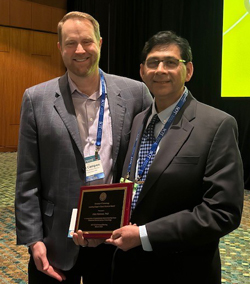 Dr. Rahman holds a PhD in biochemistry on neutrophil functions in hypertension. He completed a postdoctoral fellowship on lung toxicology at the University of Miami and Georgetown University before relocating to the University of Edinburgh, where he focused on environmental agents and lung inflammation and received an appointment as a Senior Research Scientist/Lecturer. In 2003, Dr. Rahman joined the faculty of the University of Rochester Medical Center Department of Environmental Medicine where he has risen through the faculty ranks with appointments with the Department of Public Health Sciences, Division of Pulmonary and Critical Care Medicine, and Eastman Institute for Oral Health. Since 2018, he has been the Director of the Center for Inhalation and Flavoring Toxicological Research.
Dr. Rahman holds a PhD in biochemistry on neutrophil functions in hypertension. He completed a postdoctoral fellowship on lung toxicology at the University of Miami and Georgetown University before relocating to the University of Edinburgh, where he focused on environmental agents and lung inflammation and received an appointment as a Senior Research Scientist/Lecturer. In 2003, Dr. Rahman joined the faculty of the University of Rochester Medical Center Department of Environmental Medicine where he has risen through the faculty ranks with appointments with the Department of Public Health Sciences, Division of Pulmonary and Critical Care Medicine, and Eastman Institute for Oral Health. Since 2018, he has been the Director of the Center for Inhalation and Flavoring Toxicological Research.
The research program that Dr. Rahman has developed unites the fields of circadian biology, chromatin remodeling, inflammation, sirtuin1 deacetylase (SIRT1) dynamics, and oxidants related to the impact of tobacco products on lung toxicology. He has been a longstanding pioneer with seminal contributions and cutting-edge research on mitophagy, steroid resistance, and lung cellular senescence and is a leader in the role of oxidative stress and redox signaling in gene transcription in tobacco-related pulmonary diseases. In addition, he also has been a leader in the molecular biology of chromatin remodeling and cellular senescence in the lung in response to oxidative stress and cigarette smoke and was the first to show chromatin remodeling and cellular senescence in the lung in response to cigarette smoke. He has identified several exciting potential therapies that could prevent tobacco-related lung complications from progressing.
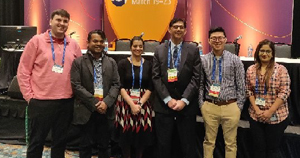 Dr. Rahman’s mechanistic discoveries and experience translated rapidly to address major issues for human health in the past five years, namely COVID-19 and e-cigarette toxicity. Of critical importance, he is constantly evolving his research to meet the challenging landscape of tobacco/e-cigarette products for lung health. For example, with regard to the rapid emergence of e-cigarettes in the high school population and the hookah waterpipe tobacco bars in college communities, Dr. Rahman already has published several papers on these products. During the pandemic, Dr. Rahman worked on COVID-19 biospecimens and showed that smokers/vapers are more susceptible to infection and are more likely to develop strong lung inflammatory response via upregulation of ACE2 via nicotine receptor alpha 7, particularly in older individuals.
Dr. Rahman’s mechanistic discoveries and experience translated rapidly to address major issues for human health in the past five years, namely COVID-19 and e-cigarette toxicity. Of critical importance, he is constantly evolving his research to meet the challenging landscape of tobacco/e-cigarette products for lung health. For example, with regard to the rapid emergence of e-cigarettes in the high school population and the hookah waterpipe tobacco bars in college communities, Dr. Rahman already has published several papers on these products. During the pandemic, Dr. Rahman worked on COVID-19 biospecimens and showed that smokers/vapers are more susceptible to infection and are more likely to develop strong lung inflammatory response via upregulation of ACE2 via nicotine receptor alpha 7, particularly in older individuals.
Dr. Rahman’s publications list consists of 225 original papers, 90 reviews, and 25 book chapters with an h-index of 110 with more than 50,000 citations; he also was selected for a list of Highly Cited Researchers by Thomson Reuters in 2014, 2015, and 2016. He has been recognized internationally and is ranked 16 of 52,718 active respiratory and allergy researchers by Ioannidis et al. (2020) He is the editor and author of Inflammation, Aging, Diet, and Nutrition, a book published by Elsevier in 2013. During his career, he has held 21 Associate Editor and Editorial Board memberships and has reviewed articles for more than 50 journals. In addition, he is the Principal Investigator on four National Institutes of Health grants.
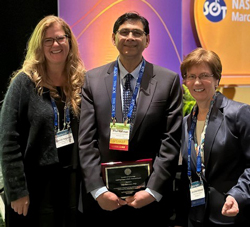 Dr. Rahman has devoted his career to teaching, understanding, and the prevention/treatment of smoking-related lung diseases. Over the years Dr. Rahman has mentored eight full-time graduate students, 30 postdoctoral scholars, and four undergraduate students, several of whom are now prominent faculty members at various institutions.
Dr. Rahman has devoted his career to teaching, understanding, and the prevention/treatment of smoking-related lung diseases. Over the years Dr. Rahman has mentored eight full-time graduate students, 30 postdoctoral scholars, and four undergraduate students, several of whom are now prominent faculty members at various institutions.
Dr. Rahman has attended the SOT Annual Meeting and ToxExpo regularly since 2003 and has been an SOT member since 2005. He has continuously provided leadership in SOT, serving as a Councilor and President of the SOT Inhalation and Respiratory Specialty Section. He also has been involved in the American Thoracic Society as a Program Committee member for the Respiratory Cell and Molecular Biology (RCMB) Assembly and created the Lung Aging Research Interest Group in the RCMB Assembly. In 2022, he received an American Thoracic Society Recognition Award for Scientific Accomplishments.
#Communique:SOTNews
#Awards
#Members
Read More: The 2023 SOT Leading Edge in Basic Science Award Recognizes Irfan Rahman for His Contributions to Pulmonary Toxicology and Specifically How E-Cig and Cigarette Smoke Causes Lung Injury and DiseaseIron & the brain: Where and when neurodevelopmental disabilities may begin during pregnancy
Monday, March 6, 2023
Study finds possible cellular origin for impairments associated with gestational iron deficiency
The cells that make up the human brain begin developing long before the physical shape of the brain has formed. This early organizing of a network of cells plays a major role in brain health throughout the course of a lifetime. Numerous studies have found that mothers with low iron levels during pregnancy have a higher risk of giving birth to a child that develops cognitive impairments like autism, attention deficit syndrome, and learning disabilities. However, iron deficiency is still prevalent in pregnant mothers and young children.
The mechanisms by which gestational iron deficiency (GID) contributes to cognitive impairment are not fully understood. The laboratory of Margot Mayer- Proschel, PhD, a professor of Biomedical Genetics and Neuroscience at the University of Rochester Medical Center, was the first to demonstrated that the brains of animals born to iron-deficient mice react abnormally to excitatory brain stimuli, and that iron supplements giving at birth does not restore functional impairment that appears later in life. Most recently, her lab has made a significant progress in the quest to find the cellular origin of the impairment and have identified a new embryonic neuronal progenitor cell target for GID. This study was recently published in the journal Development.
“We are very excited by this finding,” Mayer-Proschel said, who was awarded a $2 million grant from the National Institute of Child Health & Human Development in 2018 to do this work. “This could connect gestational iron deficiency to these very complex disorders. Understanding that connection could lead to changes to healthcare recommendations and potential targets for future therapies.”
Read More: Iron & the brain: Where and when neurodevelopmental disabilities may begin during pregnancyUniversity Launches Institute for Human Health and the Environment to Find Solutions to the 21st Century’s Most Pressing Health Issues
Friday, January 13, 2023
The foods we consume. The air we breathe. The stress we experience. The chemicals we are exposed to (willingly and unwillingly). The changing climate. Everything in and around us influences our health. Amazingly, quality of life and longevity are more closely tied to where someone lives than their genetic code.
The University of Rochester believes that finding solutions to the 21st Century’s most pressing health issues – including cancer, heart disease, neurodegenerative disorders, and our ability to fight infection – requires a collaborative commitment to research, education, and community engagement related to how the environment influences health across the lifespan. The new UR Institute for Human Health and the Environment (IHHE) will bring this vision to life.
Led by B. Paige Lawrence, Ph.D., the Institute will serve as a local and national hub to catalyze new scientific discoveries related to environmental impacts on health and transform this information into actions that will promote healthier lives for all.
“The University has been a leader in research and education in environmental health and toxicology since the 1940s, so we’re building off an extremely strong foundation,” said Lawrence, the Wright Family Research Professor and chair of the department of Environmental Medicine. “Many teams are already conducting research, teaching, and working with community members on issues related to the environment and health, but we know we can do more. It is exciting to launch this new institute, and I encourage folks to get involved. We want to hear what people across the University are passionate about and help to make their work more impactful. I encourage anyone who is interested to check out our web site and reach out to us – we want to hear from you!”
“Environmental factors such as geographic location and exposure to toxins have a profound impact on susceptibility to disease,” said Mark B. Taubman, M.D., URMC CEO and dean of the School of Medicine and Dentistry. “Some populations are disproportionately affected by these environmental risks, particularly communities of color. Collectively, we have the experience needed to partner with these communities and to use our knowledge to modify or prevent risk factors and make a difference in their lives.”
The IHHE will integrate programs and expertise from across all UR schools and will be anchored by three interactive pillars: Research; Career Development and Education; and Engagement. Initially, the Institute’s key areas of focus will include climate change and health; environmental justice; how water and air pollution impact health; and how environmental factors shape health across our whole lifetime.
Research
The IHHE will serve as a major hub for innovative and inclusive research that melds academic and scholarly disciplines. By creating new opportunities to gather knowledge and bring together different points of view, and through the sharing of expertise, the IHHE will propel research on many facets of environmental health. Gaining a better understanding of the intrinsic molecular, cellular, and socioeconomic mechanisms that underpin associations between health and the environment will transform care and lead to new ways to improve public health.
Career Development and Education
The Institute will support education and career development across all career stages. It will enhance existing programs, including an undergraduate major in Environmental Health, and multiple graduate programs, including Toxicology, Epidemiology, and Biostatistics & Computational Biology. Understanding how environmental factors influence health is already part of several other programs anchored in Public Health Sciences, Neuroscience, Engineering, and Data Science. The Institute will strengthen and extend connections between these programs and support a more diverse and inclusive environment to recruit and retain highly talented individuals. The Institute will also support programs for K-12 students in the Rochester area.
Engagement
The IHHE builds on a long history of environmental justice and community engagement related to how the lived environment influences the health of individuals and communities. This includes working with local community members to develop, evaluate, and disseminate community-based approaches to solve problems. For example, teams at UR contributed to Rochester’s local lead poisoning prevention system, which has resulted in lead poisoning rates declining 2.4 times faster than elsewhere in NY State, and has served as a national model for community-based action. Activities will be anchored in multidirectional engagement between the University and local and global partners to shape research and to evaluate and inform changes in policies, systems, and communities.
Anyone who is interested in learning more about the Institute and how they can get involved can visit the IHHE web site or reach out to the leadership team: